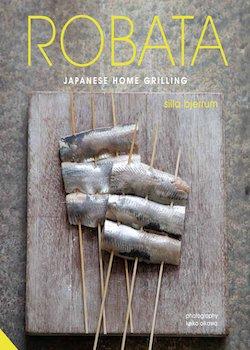Robata: Japanese Home Grilling

By Silla Bjerrum
Jacqui Small LLP, 2018
ISBN-13: 978-1911127345
Review by Niraja Singh
In May this year, the Japan Society held a successful supper club, showcasing the food and cooking of renowned chef and food consultant, Silla Bjerrum, co-founder in the late 1990s of London’s first sushi delivery service, Feng Sushi. The menu was based on her new cookbook Robata: Japanese Home Grilling published in April. Bjerrum’s recipes convey the importance of achieving umami (the fifth taste) in robatayaki through a very fast and pure form of grilling at high temperatures using natural flavour-enhancing ingredients such as soy-based sauces, miso, and shiitake mushrooms.
Japanese food has become a global phenomenon, with local sushi restaurants found in almost every corner of the world. A newer variation of this trend is Japanese cuisine involving a fusion of sushi and robata. Originating from the Hokkaido region of Japan and roughly translated as ‘fireside cooking’, robata is a ‘Japanese style of grilling food in delicious skewered morsels of fish, shellfish, meat and vegetables’. Raw and cooked dishes are served alongside one another with a focus on sharing in a kind of Japanese version of tapas.
The underlying premise of Bjerrum’s cookbook is to encourage the reader to adapt this style of cooking, which has traditionally been the preserve of restaurants, at home using good quality seasonal ingredients with an emphasis on sharing food. The dishes themselves are designed to be equally successful whether you are cooking on a traditional robata grill, outdoor barbeque or simple oven grill.
Traditionally robata cooking has been done over binchotan charcoals. Bincho coals known also as white charcoal are made from a heavy dense species of oak, with the finest coals coming from Minabe in the Wakayama prefecture of Japan. The beauty of bincho coals for grilling is that they are chemical free, almost smoke-free, burn at higher temperatures than normal charcoal and there is an absence of moisture from the bincho, hence their popularity with chefs, as this preserves the flavourful juices inside while keeping the food crispy on the outside. Yakitori is another popular form of grilling over binchotan coals, but a main difference is that robata has its roots in fish and vegetable dishes, whereas yakitori originally consisted of chicken and vegetables.
Bjerrum provides detailed instructions on how to set up a DIY robata grill at home, including the type of starter chamber in which to burn the coals initially before transferring to a drum or brick barbeque. For a makeshift robata grill in the oven, the trick is to create a mini pit high enough for skewers not to touch the base of baking sheet. Again, Bjerrum gives ample details on how to create this for the home oven. She masters a hugely accessible range of recipes, which are specifically adapted to home cooking.
Barbeque grilling in the West tends to be very meat centric, whereas Bjerrum argues that ‘robata is about delicacy, provenance and combining a selection of ingredients to create a nutritious, well-balanced meal’. Bjerrum herself does not stick wholeheartedly to the orthodox robata method, but adds her own experimental twists to create unique recipes. For example, robata grilled mussels dressed with miso flavoured butter for deep umami flavour or yuzu chicken, which is marinated in a mixture of yogurt, honey and yuzu that tenderizes the meat beautifully before grilling. More traditional Japanese fish robata dishes such as miso black cod or classic yakitori (chicken cooked on skewers) are also included in the recipes, as are a wonderful selection of vegetarian dishes such as nasu dengaku (miso glazed aubergines), goma (sesame) spinach, okra robata, and portobello mushrooms stuffed with shimeji and shiitake mushrooms. She also sets out an array of side dishes, sauces and salads, which can accompany any selection of grills from the book.
The cookbook is organised by type of robata based on ingredients, which creates an easy-to-use guide for newcomers to Japanese cuisine and is a great reference for the more experienced chef. For fish lovers, sea bream with wakame salsa and summer pickles of lemon and courgettes, Chilean sea bass with choy sum and onion relish, and soft-shell crab on crab rice are all delicious recipes to try.
The recipes are not only easy to follow, but the book itself is beautifully curated; Keiko Oikawa’s photographs perfectly capture Bjerrum’s mouth-watering food. Her cooking is a perfect introduction to Japanese cooking while simultaneously teaching you the history and theory behind robata. Do not be put off by the multitude of traditional Japanese ingredients, as they are relatively easy to find. Many are available in the local supermarket, and others readily sourced from speciality Japanese stores, which like sushi restaurants are burgeoning.
All in all, this cookbook will appeal to those with an interest in not only Japanese food, but also concerned with the provenance and seasonality of ingredients and taking their cooking to a higher level, as these have always been at the core of Bjerrum’s cooking.

